Future Development of Taiwan’s Smart Cities from an Information Security Perspective
Abstract
1. Introduction
1.1. Overall Structure of Smart Cities
1.1.1. Target Layer
1.1.2. Support Layer
1.1.3. Operations Layer
1.2. Smart City Construction in Taiwan
1.3. Smart City Information Security Framework
2. Information Security
2.1. Scope of Smart City Information Security
2.2. Cloud Computation Security
2.3. Big Data Security
2.4. Mobile Network Security
2.5. IoTs Security
3. Constructing Taiwan’s Smart City Information Security
3.1. Taiwan’s Smart City Information Security
3.2. Information Security Investment
3.2.1. Investment
3.2.2. Threats to Information Security
3.2.3. Information Security Obstacles
3.2.4. Information Security Risks
4. Conclusions
Author Contributions
Funding
Conflicts of Interest
References
- Bibri, S.E.; Krogstie, J. Smart sustainable cities of the future: An extensive interdisciplinary literature review. Sustain. Cities Soc. 2017, 31, 183–212. [Google Scholar] [CrossRef]
- Piggott, D. A Journey into Litecon Forensic Artifacts. Available online: https://www.sans.org/reading-room/whitepapers/forensics/paper/34595 (accessed on 2 November 2018).
- Taskforce. National ICT Security Development Program (2017–2020); National Information & Communication Security Taskforce: Taipei, Taiwan, 2017; pp. 1–58. [Google Scholar]
- Wu, S.; Chen, T.-C.; Wu, Y.; Lytras, M. Smart cities in Taiwan: A perspective on big data applications. Sustainability 2018, 10, 106. [Google Scholar] [CrossRef]
- Bibri, S.E.; Krogstie, J. On the social shaping dimensions of smart sustainable cities: ICT of the new wave of computing for urban sustainability. Sustain. Cities Soc. 2017, 2017, 1–45. [Google Scholar]
- Lytras, M.; Visvizi, A. Who uses smart city services and what to make of it: Toward interdisciplinary smart cities research. Sustainability 2018, 10, 1998. [Google Scholar] [CrossRef]
- Chen, J. Global Smart City Development Trends and Innovative Applications; Industrial Technology Research Institute (ITRI): Taipei, Taiwan, 2018; pp. 1–37. [Google Scholar]
- Cheng, S.; Li, H.; Cao, S. Strengthen the Use of New Generation Information Technology to Promote the Development of Smart Cities, 1st ed.; People’s Publishing House: Beijing, China, 2016. [Google Scholar]
- Yuan, Y.; Yang, W.; Gao, L.; Dong, J.; Wang, C.; Liu, Y.; Shi, R.; Yu, Y.; Yao, X.; Li, F. China Smart City Standardization White Paper; National Information Center: Beijing, China, 2013; pp. 1–59. [Google Scholar]
- NDC. 2018 National Development Plan—Building Taiwan, Seeing Execution; National Development Council: Taipei, Taiwan, 2017; pp. 1–43. [Google Scholar]
- Korotka, M.; Yin, L.R.; Basu, S.C. Information assurance technical framework and end-user information ownership: A critical analysis. J. Inf. Priv. Secur. 2016, 1, 1–16. [Google Scholar] [CrossRef]
- Chilipirea, C.; Petre, A.-C.; Groza, L.-M.; Dobre, C.; Pop, F. An integrated architecture for future studies in data processing for smart cities. Microprocess. Microsyst. 2017, 52, 335–342. [Google Scholar] [CrossRef]
- NDC. Digital Country Innovative Economic Development Program 2017–2025; National Development Committee: Taipei, Taiwan, 2017; pp. 1–428. [Google Scholar]
- NIST. Framework for Improving Critical Infrastructure Cybersecurity; National Institute of Standards and Technology: Gaithersburg, MD, USA, 2018; pp. 1–55. [Google Scholar]
- Federal. Federal Enterprise Architecture Framework. v2. Available online: https://obamawhitehouse.archives.gov/sites/default/files/omb/assets/egov_docs/fea_v2.pdf (accessed on 1 September 2018).
- Hugo, H.B. ISO/IEC 27001:2013, Your Implementation Guide. Available online: https://www.bsigroup.com/Documents/iso-27001/resources/iso-iec-27001-implementation-guide-SG-web.pdf (accessed on 4 October 2018).
- Pillai, A.K.R.; Pundir, A.K.; Ganapathy, L. Improving information technology infrastructure library service delivery using an integrated lean six sigma framework: A case study in a software application support scenario. J. Softw. Eng. Appl. 2014, 7, 483–497. [Google Scholar] [CrossRef][Green Version]
- Collins, A. WEF the Global Risk Report 2018. Available online: https://outlook.stpi.narl.org.tw/index/focusnews/detail/443 (accessed on 20 October 2018).
- Christopher, C. Revitalizing Privacy and Trust in a Data-Driven World- Key Findings from the Global State of Information Security Survey 2018. Available online: https://www.pwc.com/gsiss (accessed on 15 October 2018).
- Jian, H. Current Security Situation Analysis; Communications Security Council: Taipei, Taiwan, 2017; pp. 1–15. [Google Scholar]
- Fan, Y. Smart City and Information Security, 2nd ed.; Publishing House of Electronics Industry: Beijing, China, 2017; p. 330. [Google Scholar]
- Mogull, R.; Arlen, J.; Gilbert, F.; Lane, A.; Mortman, D.; Peterson, G.; Rothman, M. The Security Guidance for Critical Areas of Focus in Cloud Computing v4.0. Available online: https://downloads.cloudsecurityalliance.org/assets/research/security-guidance/security-guidance-v4-FINAL.pdf (accessed on 15 September 2018).
- Lin, Y. A study on current situation and future trend of cybercrime and digital forensics in Taiwan—Take the ‘innovative judicial police IEK intelligence model’ as an example. Proc. Crim. Policy Crime Res. 2018, 20, 289–330. [Google Scholar]
- Nissenbaum, H. Privacy as contextual integrity. Wash. Law Rev. 2004, 79, 101–140. [Google Scholar]
- Lugmayr, A.; Stockleben, B.; Scheib, C.; Mailaparampil, M.A. Cognitive big data: Survey and review on big data research and its implications. What is really “new” in big data? J. Knowl. Manag. 2017, 21, 197–219. [Google Scholar] [CrossRef]
- Fujitsu, S.R.; Verizon, W.V.G.; eBay, N.S. Expanded Top Ten Big Data Security and Privacy Challenges. Available online: https://downloads.cloudsecurityalliance.org/initiatives/bdwg/Expanded_Top_Ten_Big_Data_Security_and_Privacy_Challenges.pdf (accessed on 1 October 2018).
- Cárdenas, A.A.; Manadhata, P.K.; Fujitsu, S.R. Big Data Analytics for Security Intelligence. Available online: https://downloads.cloudsecurityalliance.org/initiatives/bdwg/Big_Data_Analytics_for_Security_Intelligence.pdf (accessed on 1 October 2018).
- Yang, R.; Wu, S. The Application of Big Data—Taking the Financial Industry as an Example; Azion Group: Taipei, Taiwan, 2018; pp. 1–15. [Google Scholar]
- Liao, W. Data Analysis, Data Integration, Data Quality, Omni-Directional Big Data Integration Platform. Available online: http://www.azion.com.tw/page2.aspx?cid=103&lid=112&cat_num=2 (accessed on 10 October 2018).
- Wu, P. Ainvr ai Deeping Learning Technologies and Case Study; Aizon Group: Taipei, Taiwan, 2018; pp. 1–30. [Google Scholar]
- MOTC. Third Generation Mobile Communication Business Management Rules; National Communications Commission: Taipei, Taiwan, 2018; pp. 1–22. [Google Scholar]
- Cichonski, J.; Franklin, J.M.; Bartock, M. Guide to ITE Security. Available online: https://nvlpubs.nist.gov/nistpubs/specialpublications/nist.sp.800-187.pdf (accessed on 10 October 2018).
- He, D.; Chan, S.; Guizani, M. Handover authentication for mobile networks: Security and efficiency aspects. IEEE Netw. 2015, 29, 96–103. [Google Scholar] [CrossRef]
- Zheng, Y.; Moini, A.; Lou, W.; Hou, Y.T.; Kawamoto, Y. Cognitive security: Securing the burgeoning landscape of mobile networks. IEEE Netw. 2016, 30, 66–71. [Google Scholar] [CrossRef]
- CISCO. Cisco IoT Networking Deploy, Accelerate, Innovate. Available online: http://www.cisco.com/go/iot (accessed on 10 October 2018).
- Alaba, F.A.; Othman, M.; Hashem, I.A.T.; Alotaibi, F. Internet of things security: A survey. J. Netw. Comput. Appl. 2017, 88, 10–28. [Google Scholar] [CrossRef]
- Zhou, W.; Zhang, Y.; Liu, P. The effect of iot new features on security and privacy: New threats, existing solutions, and challenges yet to be solved. IEEE Access 2018, 1–11. [Google Scholar] [CrossRef]
- The Open Web Application Security Project. The Ten Most Critical Web Application Security Risks. Available online: https://www.owasp.org/images/7/72/OWASP_Top_10-2017_%28en%29.pdf.pdf (accessed on 12 October 2018).
- Cleary, G.; Corpin, M.; Cox, O.; Lau, H.; Nahorney, B.; O’Brien, D.; O’Gorman, B.; Power, J.-P.; Wallace, S.; Wood, P.; et al. Internet Security Threat Report. Available online: https://www.symantec.com/content/dam/symantec/docs/reports/istr-23-2018-en.pdf (accessed on 15 September 2018).
- Qin, W. Taipei Smart City Development Policy and Application Cases; Institute for Information Industry: Taipei, Taiwan, 2018; pp. 1–31. [Google Scholar]
- CISCO. Cisco 2018 Annual Network Security Report. Available online: ahttps://www.cisco.com/c/dam/global/zh_tw/products/security/acr-report-2018/final_files_cisco_2018_acr_web_tw.pdf (accessed on 20 October 2018).
- Gartner. 2018 Global Cio Survey. Available online: https://www.gartner.com/smarterwithgartner/the-2018-cio-agenda-infographic/ (accessed on 10 October 2018).
- iThome. Ithome 2018 Enterprise Security Survey: Information Security Investment Trends, Information Security Manpower Compilation, Corporate Information Security Defense Status, Information Security Incident Impact; iThome (Taiwan): Taipei, Taiwan, 2018. [Google Scholar]
- iThome. Ithome 2018 Corporate Cio Survey; iThome (Taiwan): Taipei, Taiwan, 2018. [Google Scholar]
- Wu, P. Artificial Intelligence Network Video Recorder. Available online: http://www.azion.com.tw/page.aspx?cid=101&lid=107 (accessed on 20 October 2018).
- Tu, J.; Xu, X.; Wang, Y.; Zeng, X.; Yang, Z.; Lin, S.; Yu, Q.; Wang, W. Ernst & Young 20th Global Information Security Survey Report. Available online: https://www.ey.com/Publication/vwLUAssets/ey-cybersecurity-regained-preparing-to-face-cyber-attacks-tw/$FILE/ey-cybersecurity-regained-preparing-to-face-cyber-attacks-tw.pdf (accessed on 25 October 2018).
- Visvizi, A.; Lytras, M.D. Rescaling and refocusing smart cities research: from mega cities to smart villages. J. Sci. Technol. Policy Manag. 2018, 9, 134–145. [Google Scholar] [CrossRef]
- Sicilia, M.; Visvizi, A. Blockchain and OECD data repositories: opportunities and policymaking implications. Libr. Hi Tech. 2018. [Google Scholar] [CrossRef]
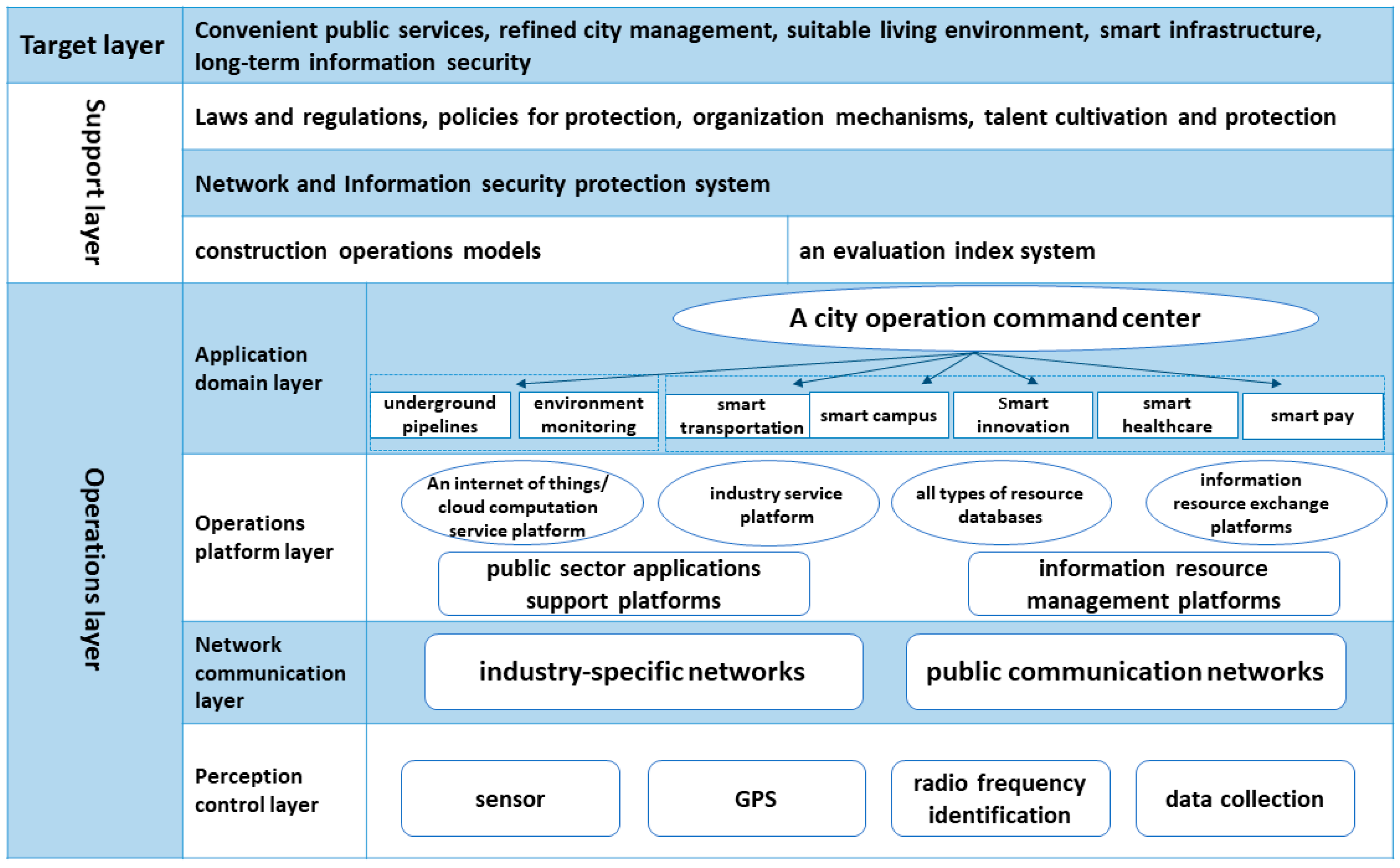
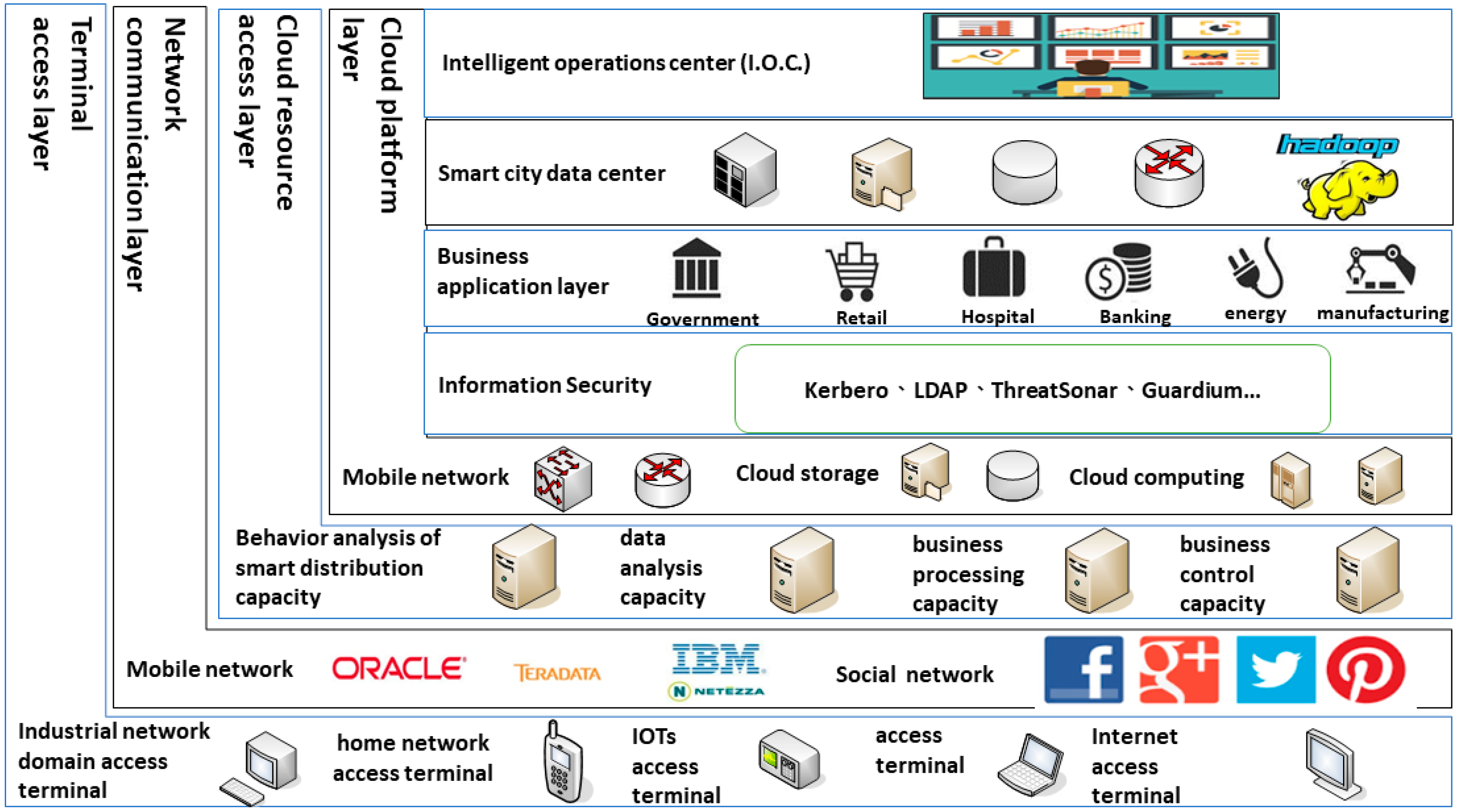
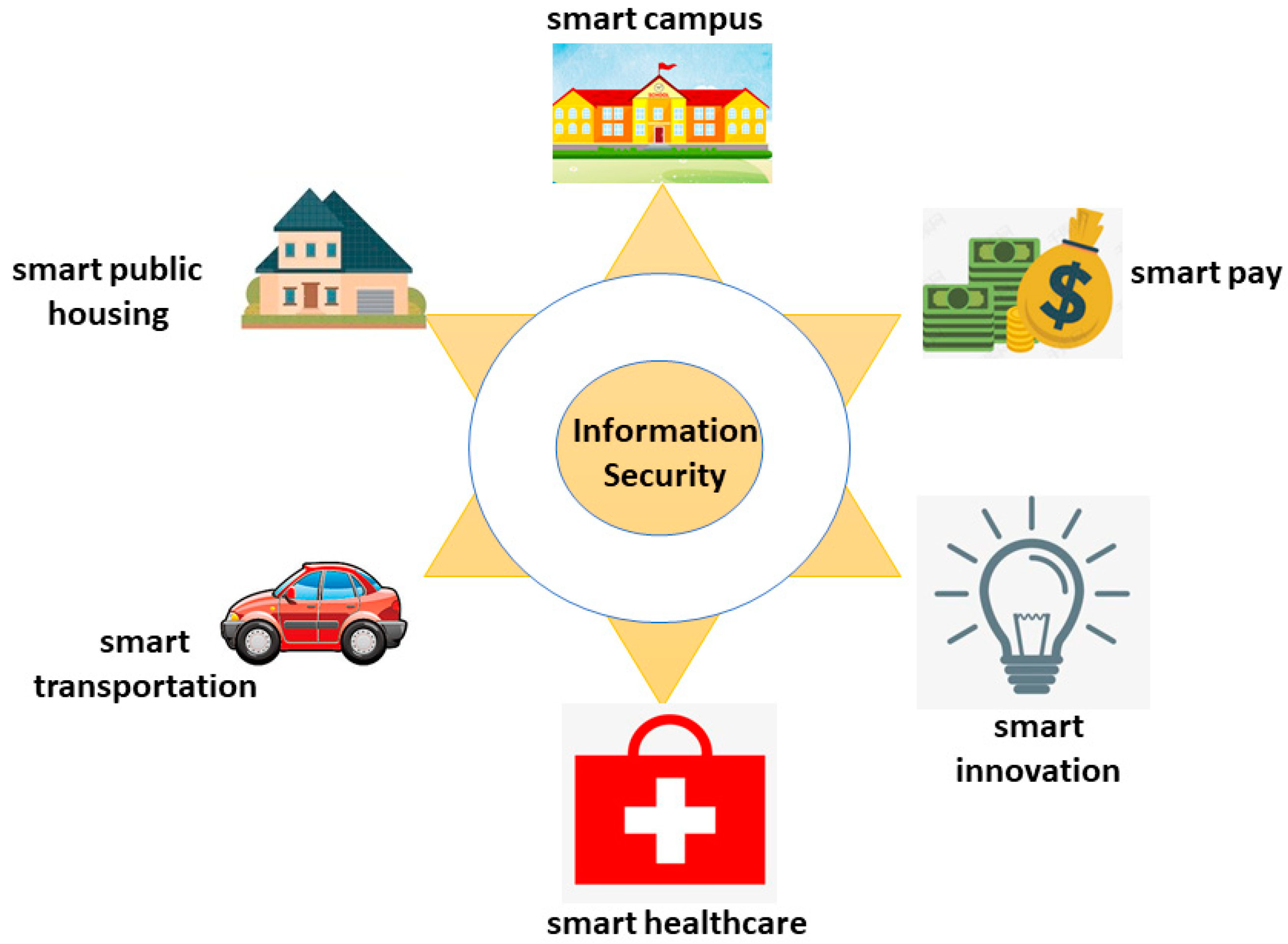
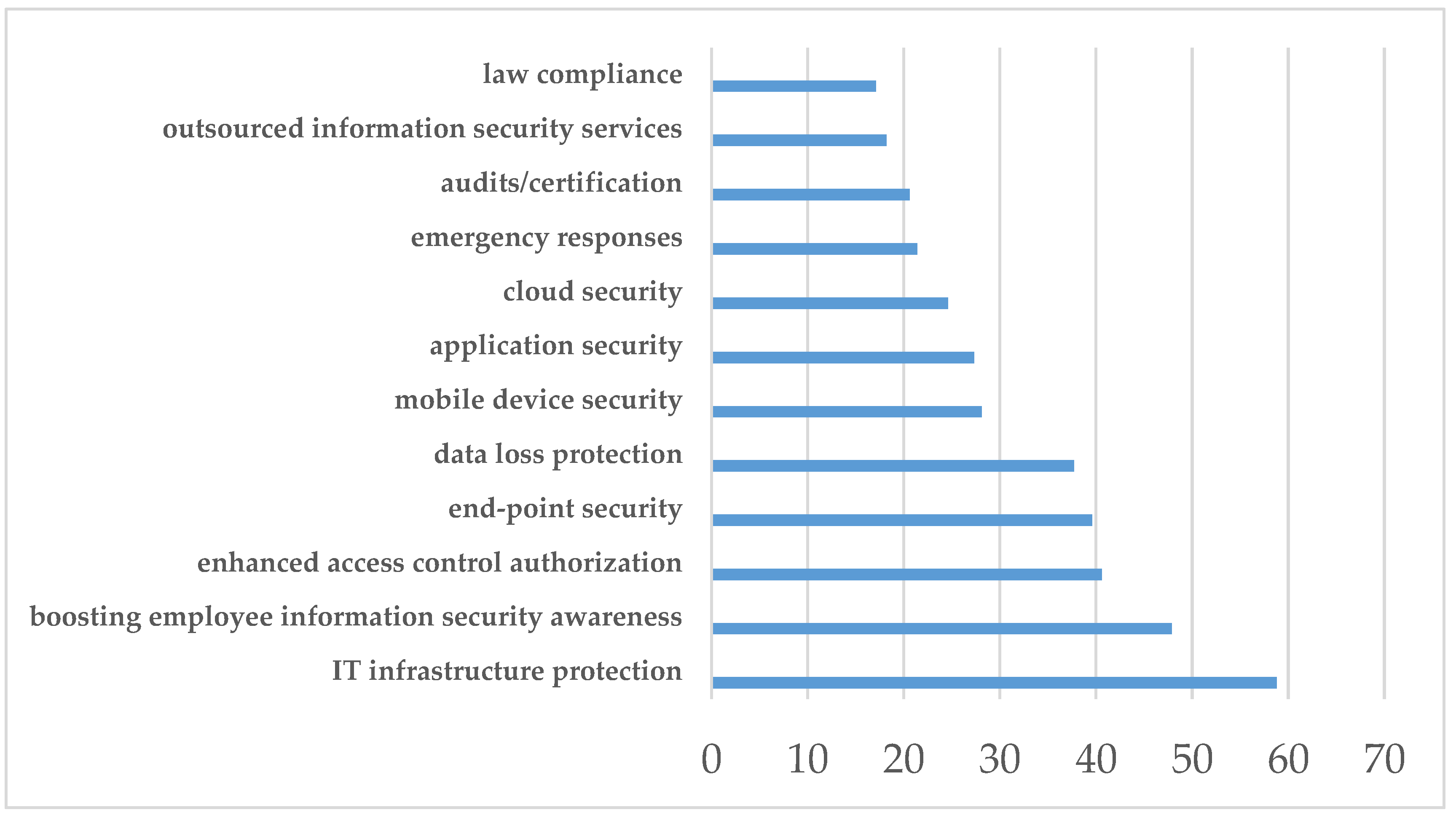
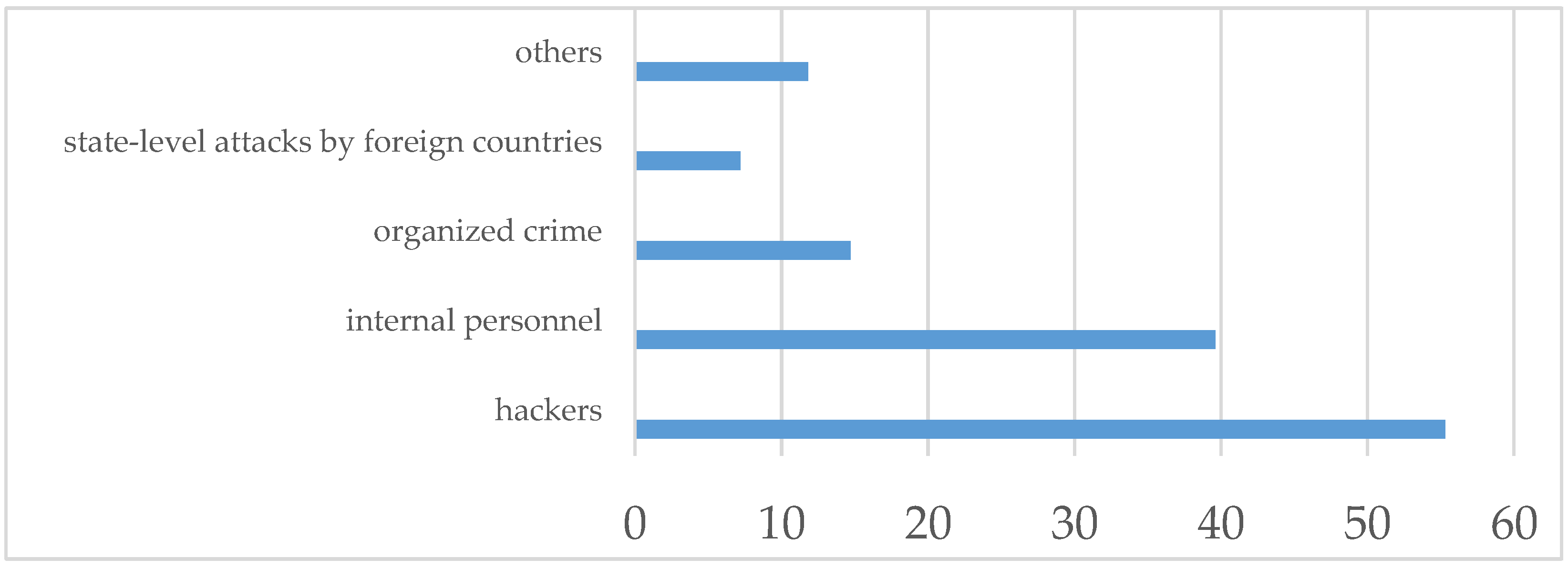
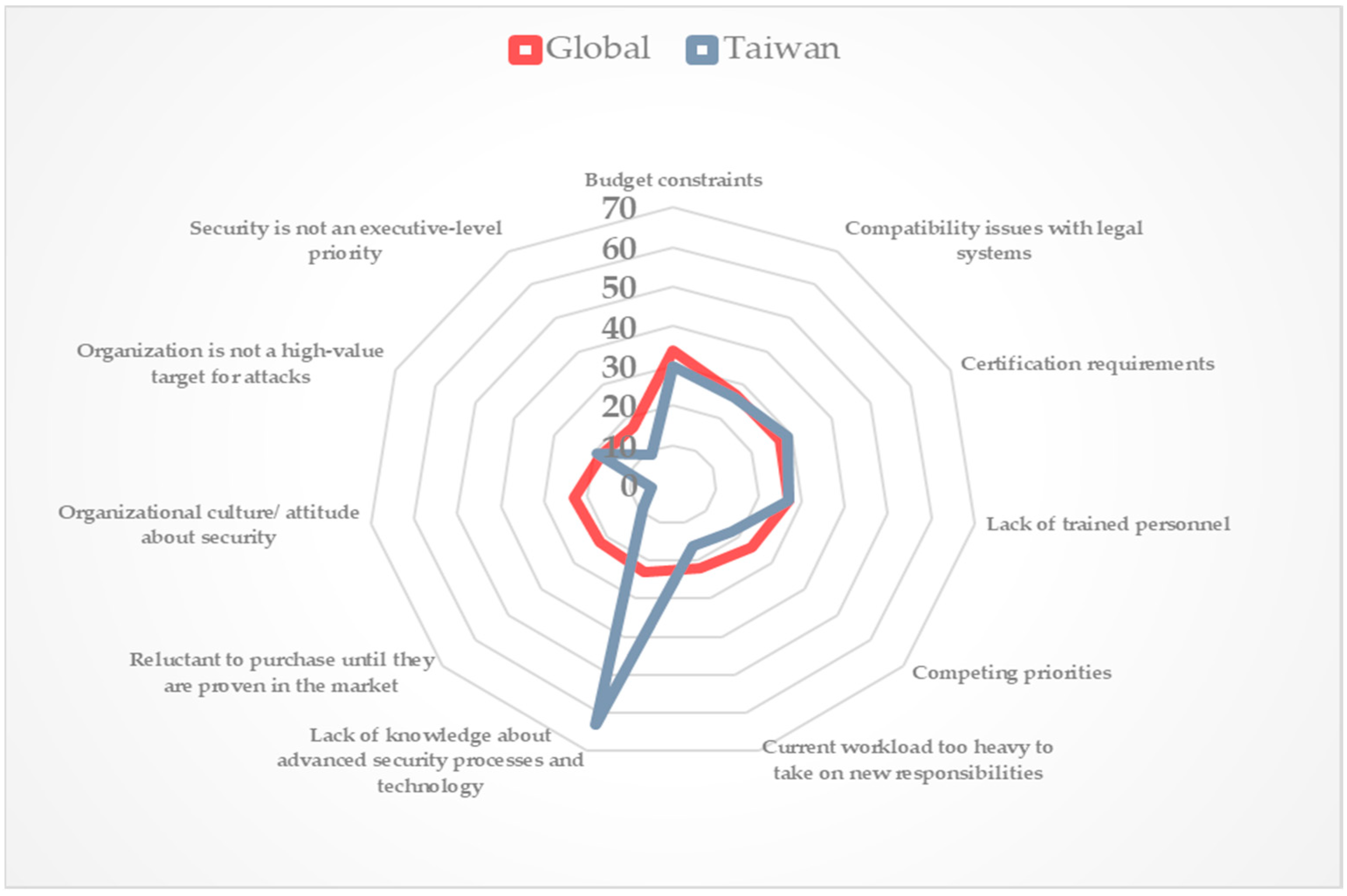
| Information Security Working Domain | Applications Involved | Basic Information Security Protection Strategies |
|---|---|---|
| Business applications | All types of smart applications, user data, network data, business data, and big data | Access control, invasion control, and action and behavioral audits are rigorously implemented, and digital certificates are used for identity certification, identification, and scanning for vulnerabilities. |
| Cloud platform | Cloud storage, cloud computation, cloud networks, cloud resources, and big data | Protection is implemented according to the 13 critical domains listed in the Cloud Security Alliance cloud computation security guidelines. |
| Cloud resource access layer | Cloud resource controllers, load balancer, bandwidth aggregation, and distributed storage | Access control, invasion control, and action and behavioral audits are rigorously controlled, and digital certificates are used for identity certification and identification. Furthermore, application layer protection and data recovery are implemented. |
| Mobile network communication layer | Communication links, wide area network access devices, and wireless base station devices | Rigorous access control, invasion detection, and encrypted transmission are implemented to ensure network communication security. |
| Terminal access layer | Desktop terminals, mobile terminals, IoT (Internet of Things) sensor terminals, and smart electric appliances | Virus filtering, alarm and isolation, terminal access, terminal security management, field control, application layer filtering defense, and IoT security defense. |
| Type | Name | Description |
|---|---|---|
| Information security guidelines | Cloud computation security guidance | CSA. V 4.0 |
| Guidelines for Improving Security and Privacy in Public Cloud, NIST (National Institute of Standards and Technology, Special Publication). | NIST SP 800-144 | |
| 27017 and 27018 for cloud computation data and privacy protection standards, the International Organization for Standardization (ISO). | ISO 270xx | |
| Business continuity management system (BCMS). | ISO 22301 | |
| Application standards | The Health Insurance Portability and Accountability Act of 1996 (HIPAA) provides data privacy provisions for medical facilities and subcontractors. | HIPAA |
| Data security check provisions for financial institutions, Federal Financial Institutions Examination Council (FFIEC). | Finance FFIEC | |
| Information privacy provisions for credit card and debit card information, the PCI (Payment Card Industry) Security Council. | PCI | |
| SAS 70 (the Statement on Auditing Standards No.70) for performing risk control audits of financial institutions and of institutions providing information services. | SAS 70 | |
| Technical standards | Key and certificate management: KMIP (Key Management Interoperability Protocol) and PKCS (Public Key Cryptography Standards). | KMIP stands for the Key Management Interoperability Protocol, whereas PKCS stands for Public Key Cryptography Standards. |
| Information storage security: The Institute of Electrical and Electronics Engineers (IEEE) P1619. | Data storage encryption method and key management structure, the Security in Storage Working Group of IEEE. | |
| Identity authentication: SAML (Security Assertion Markup Language) and X.509 certificate. | SAML stands for Security Assertion Markup Language; Public key management and infrastructure (X.509 authentication) of the International Telecommunication Union Standardization Sector. |
| Category | Ten Major Challenges for Big Data Security and Privacy |
|---|---|
| Infrastructure safety | Decentralized computing architecture security; Security best practices in nonrelational data stores. |
| Data privacy | Data mining and analysis of privacy protection; Data security with boosted cryptography; Refined access control. |
| Data management | Data storage and transaction record security; Refined audits; Data source. |
| Integrity and reactive security | Terminal input authentication and filtering; Real-time security monitoring. |
| Security Budget under IT Budget | 2014 (Effective Number of Samples, n = 1673) | 2015 (Effective Number of Samples, n = 2374) | 2016 (Effective Number of Samples, n = 2828) |
|---|---|---|---|
| Fully under IT | 61% | 58% | 55% |
| Partially under IT | 33% | 33% | 36% |
| Completely independent | 6% | 9% | 9% |
| Item | Global: 2018 Cisco Global Survey | Taiwan: 2018 iThome Survey | |
|---|---|---|---|
| Column A1 2016 (Effective Number of Samples, n = 2912) | Column A2 2017 (Effective Number of Samples, n = 3651) | Column B 2017 (Effective Number of Samples, n = 462) | |
| Budget constraints | 35% | 34% | 30% |
| Compatibility issues with legal systems | 28% | 27% | 26% |
| Certification requirements | 25% | 27% | 29% |
| Lack of trained personnel | 25% | 27% | 27% |
| Competing priorities | 24% | 24% | 18% |
| Current workload too heavy to take on new responsibilities | 23% | 22% | 16% |
| Lack of knowledge about advanced security processes and technology | 22% | 23% | 63% |
| Reluctant to purchase until they are proven in the market | 22% | 22% | 9% |
| Organizational culture/attitude about security | 22% | 23% | 5% |
| Organization is not a high-value target for attacks | 18% | 18% | 19% |
| Security is not an executive-level priority | 17% | 17% | 9% |
| Risks | Information Security Risks of Greatest Concern to Taiwanese CIOs (Chief Information Officers) by Percentage (Effective Number of Samples, n = 462) | Increasing Annual Rates of Corresponding Types of Global Virus according to an ISTR 2017 Survey (Effective Number of Samples, n = 15,000) |
|---|---|---|
| Phishing emails | 50.8% | 71% |
| Malware | 46.3% | 92% |
| Blackmail software | 45.2% | 46% |
| Junk mail | 35% | 55% |
| Using mobile devices | 23% | 54% |
| Potential vulnerabilities for possible attacks or damage | 18.7% | 13% |
© 2018 by the authors. Licensee MDPI, Basel, Switzerland. This article is an open access article distributed under the terms and conditions of the Creative Commons Attribution (CC BY) license (http://creativecommons.org/licenses/by/4.0/).
Share and Cite
Wu, S.M.; Guo, D.; Wu, Y.J.; Wu, Y.C. Future Development of Taiwan’s Smart Cities from an Information Security Perspective. Sustainability 2018, 10, 4520. https://doi.org/10.3390/su10124520
Wu SM, Guo D, Wu YJ, Wu YC. Future Development of Taiwan’s Smart Cities from an Information Security Perspective. Sustainability. 2018; 10(12):4520. https://doi.org/10.3390/su10124520
Chicago/Turabian StyleWu, Shiann Ming, Dongqiang Guo, Yenchun Jim Wu, and Yung Chang Wu. 2018. "Future Development of Taiwan’s Smart Cities from an Information Security Perspective" Sustainability 10, no. 12: 4520. https://doi.org/10.3390/su10124520
APA StyleWu, S. M., Guo, D., Wu, Y. J., & Wu, Y. C. (2018). Future Development of Taiwan’s Smart Cities from an Information Security Perspective. Sustainability, 10(12), 4520. https://doi.org/10.3390/su10124520






